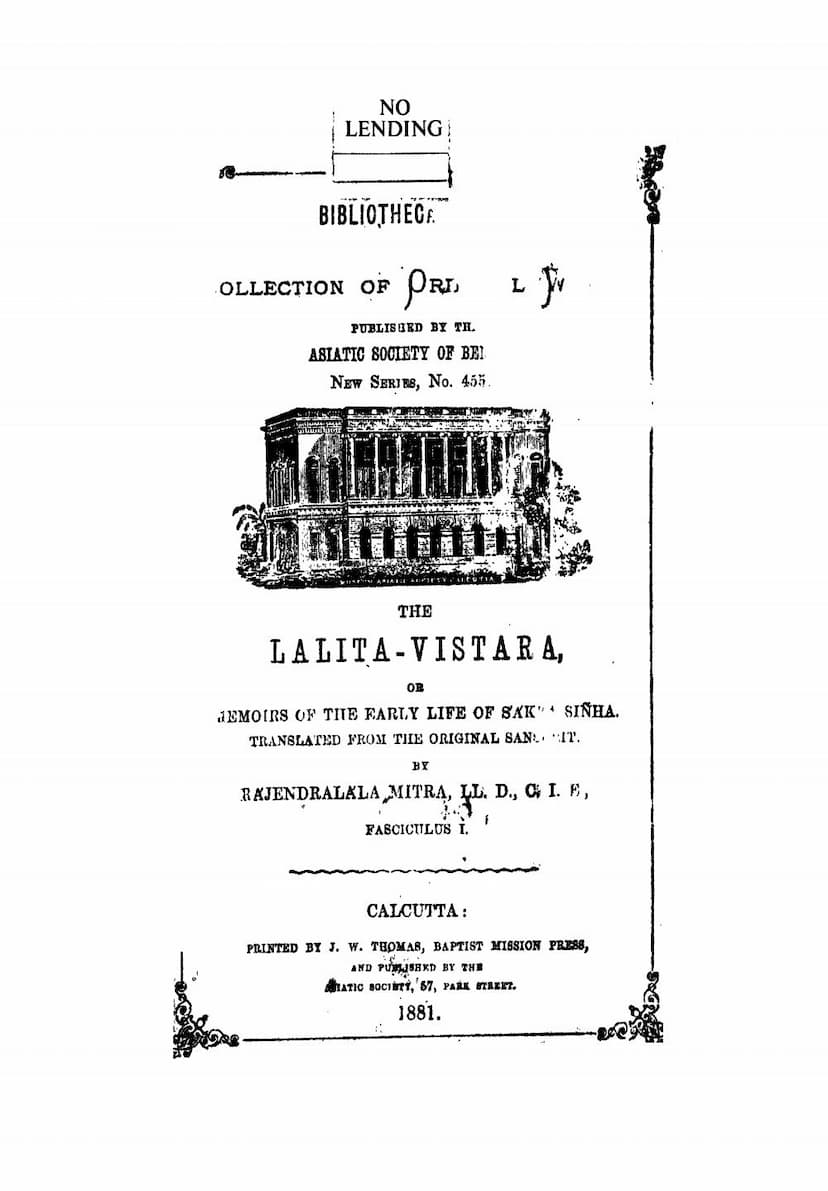Lalit Vistara
Added to library: September 2, 2025

Summary
This text is the first fasciculus (part) of a translation of the Lalita-Vistara, also known as "Memoirs of the Early Life of S'akya Sinha," by Rajendralala Mitra. The book was published by the Asiatic Society in Calcutta in 1881 as part of their Bibliotheca Indica series.
The provided text, primarily Chapter 1, focuses on the introductory discourse and the events leading up to the Bodhisattva's decision to descend to earth.
Here's a breakdown of the key elements:
- The Setting: The narrative begins with the Bhagaván (Buddha) residing in the garden of Jetavana in S'ravasti, accompanied by a large retinue of venerable disciples (Bhikshukas) and thirty-two thousand Bodhisattvas.
- The Request: A request is made by the Bodhisattvas and Devaputras (celestial beings) to the Bhagaván to recite the Lalita-Vistara. They describe its contents as a treatise on religion that expounds the source of Bodhisattva blessings, the light of Tushita heaven, Buddha's career, birth, childhood excellencies, worldly proficiencies, conjugal enjoyments, and the method of acquiring final rewards.
- Bhagaván's Vow: Bhagaván benignly vouchsafes their request for the good of all, for the diffusion of Maháyána, and out of great compassion for gods and men.
- The Divine Vision: While meditating on the "Ornament of Buddha," a flame of light emanates from the crown of Bhagaván's head, illuminating the residences of the gods. This light inspires didactic verses that extol the virtues of S'akya Sinha.
- The Devaputras' Plea: Touched by this divine light and inspired by the verses, the Devaputras, including Mahesvara and others, approach Bhagaván and reiterate their request for him to relate the Lalita-Vistara. They emphasize its importance as a treatise expounding the entirety of former Tathagata Buddhas' teachings.
- Bhagaván's Acceptance: Bhagaván, in great compassion, silently accepts their request.
- The Narrative of the Vision: Bhagaván recounts how, during the night, several Devaputras visited him and entreated him to recite the Lalita-Vistara, which was propounded by former Tathagatas for the benefit of past generations.
- The Purpose of the Recitation: Bhagaván states that he will recite this amplified Sútra for the benefit of generations past, for the removal of Bodhisattvas' sins, and for the utter overthrow of the demon of love (Namuchi).
- The Invitation to Listen: Bhagaván then invites the Bhikshukas to listen to the amplified Sútra.
Key Concepts and Figures Mentioned:
- Bhagaván/Buddha: The central figure, addressed with honorific titles like "Lord," "Sage," "Teacher of gods and men."
- Bodhisattvas: Beings of high spiritual rank, actively involved in the request and listening to the discourse. Principal among them are Maitreya, Dháraṇívaraja, Siṅketa, and others.
- Devaputras: Celestial beings, including Mahesvara, Nanda, Sunanda, who play a role in initiating the discourse.
- S'rávakas: Disciples who also join in the request.
- Tushita Heaven: The celestial abode where Bodhisattvas often reside before their final birth.
- Lalita-Vistara: The text itself, described as an "amplified treatise on religion" and the "noblest of Sútras."
- Tathagatas: Previous Buddhas.
- Mára/Namuchi: The demon of sensual desire, an adversary of the Buddha.
- Brahmacharya: A state of religious discipline and chastity.
- S'akya Sinha: Another name for Buddha, referring to his lineage.
- Lokadháttu: The world-systems or realms of existence.
- Gáthás: Didactic verses.
The initial chapter sets the stage for the detailed account of Siddhartha's life, emphasizing the divine orchestration and the profound significance of the teachings to be revealed in the Lalita-Vistara. The translation is marked by extensive footnotes explaining various Buddhist and Hindu terms, concepts, and historical context, highlighting the intermingling of traditions.